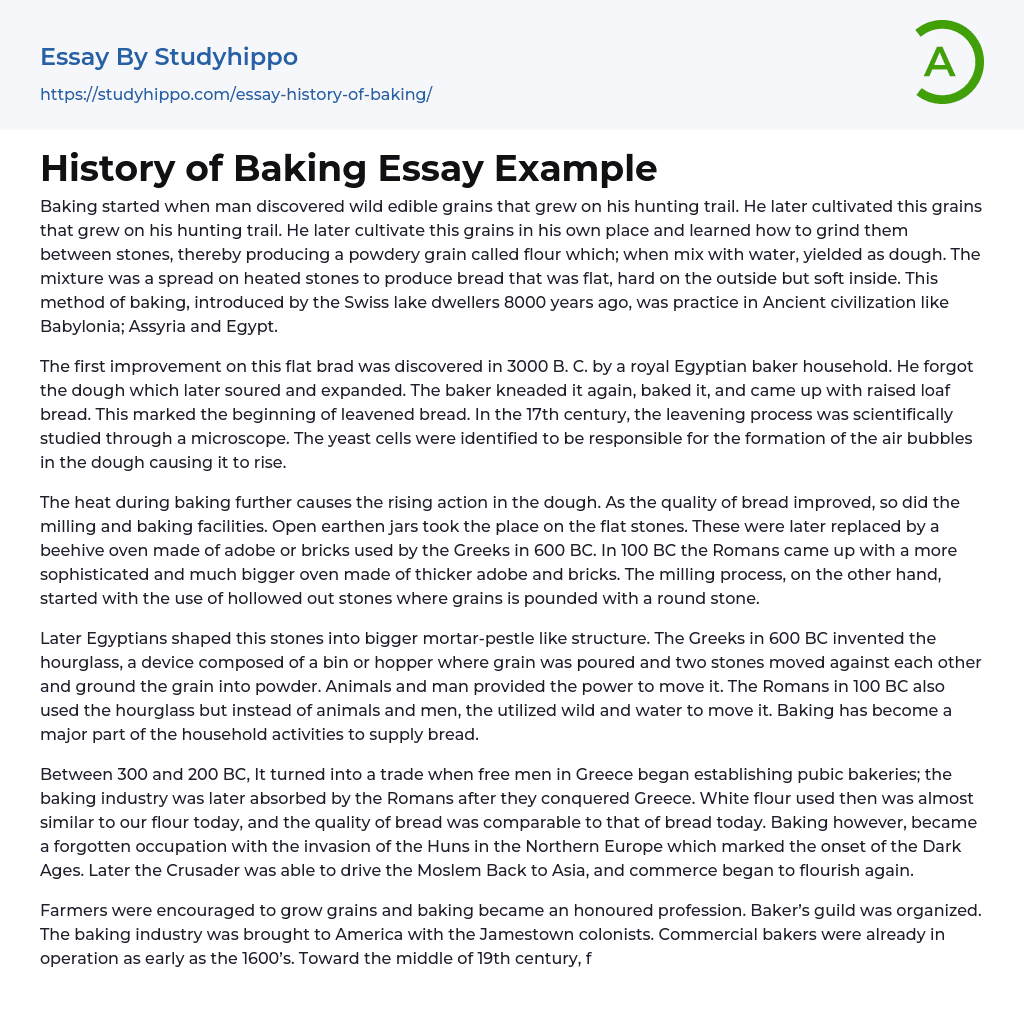Baking started when man discovered wild edible grains that grew on his hunting trail. He later cultivated this grains that grew on his hunting trail. He later cultivate this grains in his own place and learned how to grind them between stones, thereby producing a powdery grain called flour which; when mix with water, yielded as dough. The mixture was a spread on heated stones to produce bread that was flat, hard on the outside but soft inside. This method of baking, introduced by the Swiss lake dwellers 8000 years ago, was practice in Ancient civilization like Babylonia; Assyria and Egypt.
The first improvement on this flat brad was discovered in 3000 B. C. by a royal Egyptian baker household. He forgot the dough which later soured and expanded. The
...baker kneaded it again, baked it, and came up with raised loaf bread. This marked the beginning of leavened bread. In the 17th century, the leavening process was scientifically studied through a microscope. The yeast cells were identified to be responsible for the formation of the air bubbles in the dough causing it to rise.
The heat during baking further causes the rising action in the dough. As the quality of bread improved, so did the milling and baking facilities. Open earthen jars took the place on the flat stones. These were later replaced by a beehive oven made of adobe or bricks used by the Greeks in 600 BC. In 100 BC the Romans came up with a more sophisticated and much bigger oven made of thicker adobe and bricks. The milling process, on the other hand, started with the
use of hollowed out stones where grains is pounded with a round stone.
Later Egyptians shaped this stones into bigger mortar-pestle like structure. The Greeks in 600 BC invented the hourglass, a device composed of a bin or hopper where grain was poured and two stones moved against each other and ground the grain into powder. Animals and man provided the power to move it. The Romans in 100 BC also used the hourglass but instead of animals and men, the utilized wild and water to move it. Baking has become a major part of the household activities to supply bread.
Between 300 and 200 BC, It turned into a trade when free men in Greece began establishing pubic bakeries; the baking industry was later absorbed by the Romans after they conquered Greece. White flour used then was almost similar to our flour today, and the quality of bread was comparable to that of bread today. Baking however, became a forgotten occupation with the invasion of the Huns in the Northern Europe which marked the onset of the Dark Ages. Later the Crusader was able to drive the Moslem Back to Asia, and commerce began to flourish again.
Farmers were encouraged to grow grains and baking became an honoured profession. Baker’s guild was organized. The baking industry was brought to America with the Jamestown colonists. Commercial bakers were already in operation as early as the 1600’s. Toward the middle of 19th century, facilities and baked products saw improvements bigger and more efficient ovens were built. Products like breads, cakes, pies, biscuits, cookies and crackers became commercially available. The import and export of
wheat encourage the growth of the industry.
- Russian Empire essays
- Ancient Greece essays
- British Empire essays
- Historical Figures essays
- Nazi Germany essays
- Roman Empire essays
- War essays
- Revolution essays
- 19Th Century essays
- Historiography essays
- History of the United States essays
- 20Th Century essays
- World History essays
- Vikings essays
- Declaration of Independence essays
- Civilization essays
- Evidence essays
- Genocide essays
- Colonialism essays
- Rebellion essays
- 1960S essays
- 1920S essays
- 1950S essays
- Letter from Birmingham Jail essays
- Louisiana Purchase essays
- The Columbian Exchange essays
- World Hunger essays
- What is History essays
- Bravery essays
- Gilded Age essays
- Vladimir Lenin essays
- Alexander The Great essays
- Sparta essays
- Victorian Era essays
- Henry v essays
- Stonehenge essays
- Frederick Douglass essays
- Mahatma Gandhi essays
- Joseph Stalin essays
- Geert Hofstede essays
- George Eliot essays
- Ginevra King essays
- John Keats essays
- Siegfried Sassoon essays
- Ben jonson essays
- Billy elliot essays
- Wilkie collins essays
- John Proctor essays
- Harriet Tubman essays
- Napoleon essays




